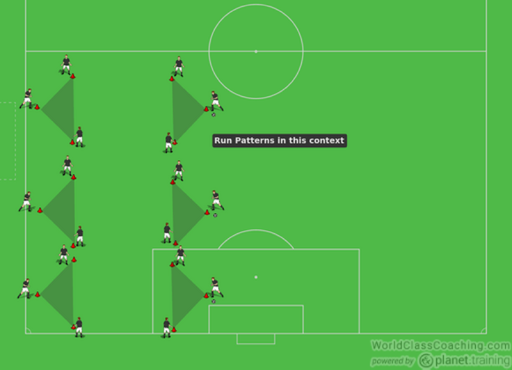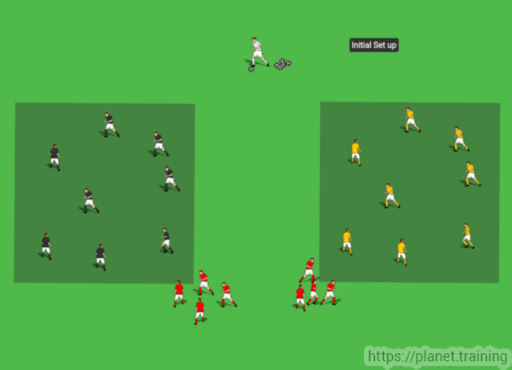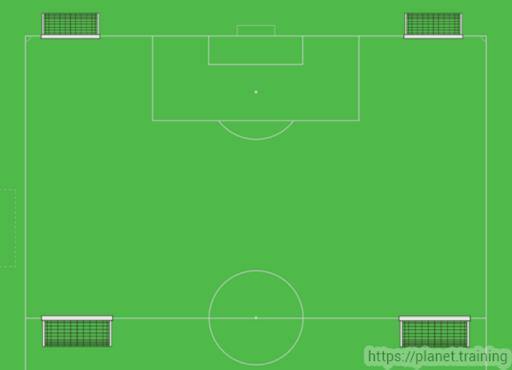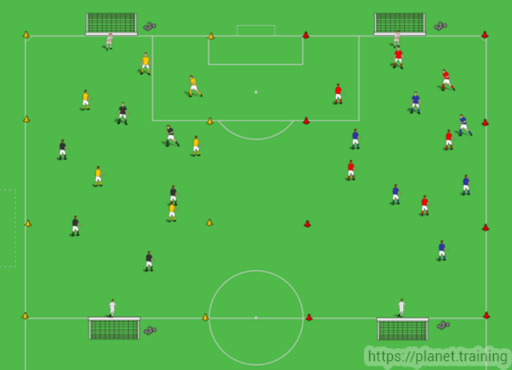By Steven Smith
This training session is designed to teach the team the importance of transitioning up and down the field while still focusing on lateral wing play. If teams are able to get the ball to the wing on the attack or for targets coming out of the back then the rest of the team must move in quick transition to support the play or become targets in the box. All incentives in this training session after the technical warm-up are designed to emphasize this transition. All feedback must be given on the focus and effort of transition to support play.
Activity 1: Brazilian Triangle Series for Warm-up
Warm-up

Setup:
Three to four sets of the triangles are set up as shown in the first diagram. Three players are in each triangle and set up on the cone in each location. Distance between cones should be about five yards within the triangle and 15 yards between triangle sets.
Execution:
Players execute a series of predetermined passing sequences as shown in each diagram. Players should eventually become so adept at this warm up that it can be led by the players with the switching of the patterns being done by the leaders of your group. Spend approximately three minutes on each passing sequence before switching sides.
Variations:
1. Coach can set up competitions between the groups to see how many passes in a pattern can be accomplished in a set amount of time.
2. Coach can change up the size of the triangles in increasingly bigger distances and switch groups to each of the increasingly bigger spaces. The precision of passing touches can be translated to the larger spaces that may occur in the game.
Comment
Lengthen distance on space for long pass to 26 yards.
Activity 2: 8v8v8 Transition
Main phase

Setup: Two grids are set up 20X20 yards with a 20-yard gap in between them. Teams are divided into three groups of 8 (or other combinations of numbers).
Execution: Black team in one grid and Yellow team in the other grid. The red team remains outside of each grid with 4 players from the red team at each grid. Coach serves the ball into one grid and the four red players enter to defend and stop the black team from connecting 8 passes. If the red team knocks the ball out of the grid they exit the grid to the waiting point again and the coach immediately serves a ball into the yellow grid. The reds waiting there must do the same thing and keep the yellow group from connecting 8 passes. If the teams are successful in connecting 8 passes and sending the ball to the opposite grid, then the yellow defenders must switch to defending the opposite grid. See diagrams. Two minute games and then rotate defensive group colors.
This works amazingly well! Two minute rounds for each team. Keep score of completed points.
Activity 3: 4 Goal Half Field
Main phase

Setup: Half a field is set up with two goals on flanks of end line and two on flanks of the midfield stripe. Teams of 11 are divided in half and four goalkeepers occupy the full-size goals. Emphasize lateral transition defensively and on attack.
Execution: Players are instructed to defend their two goals and attack the opposing two goals. As play gets jammed up, the players should change the point of attack.
Variations:
Players change point of attack by combining with midfield players.
Players change point of attack by long ball only
Comment
Two ten minute games.
Activity 4: 6 vs. 6 half field split
Main phase

Setup: Split half field in half and divide teams into groups of 6.
Execution: Play two games at once in tournament fashion. Keep score and rotate till all play each other for three rounds.
Variations:
Various restrictions such as touches can be applied.
Rotate to have all play each other. Keep score with punishment.
By Steven Smith Head Coach at Hope College, Holland, MI


